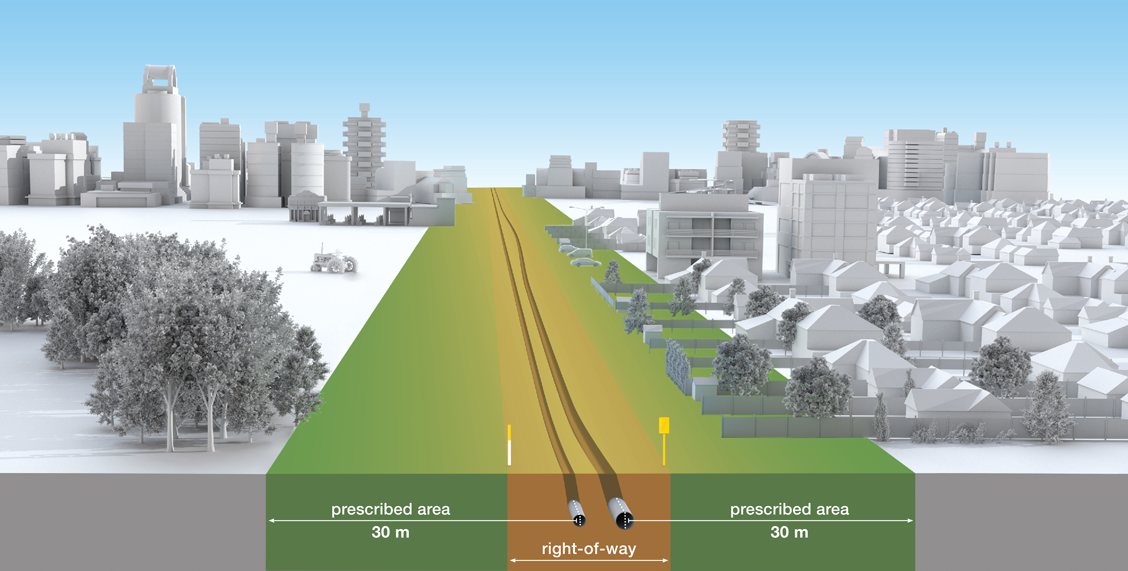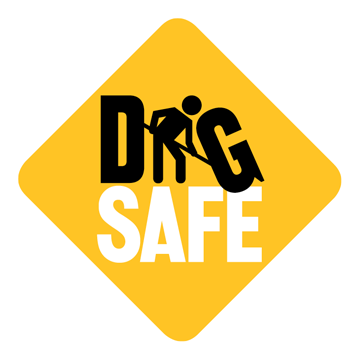Contractors

View the full Construction Near Pipelines booklet online, or download a printable copy [PDF 7667 KB].
Who this is for
This section is for any company, contractor or person working near a pipeline.
On this page
- Activities and equipment
- Working in the prescribed area: what you need to know
- For those living and working near pipelines
- Planning projects around pipelines
- Activities that do not need consent from the pipeline company
- Activities that need consent from the pipeline company
- What if plans change?
- Driving off a roadway in the prescribed area
- Building or maintaining overhead lines
- Maintenance for an existing facility in the prescribed area
- Know your responsibilities
- Agreeing to activities and costs
- Get help from the CER to reach agreements
- If you don’t follow the regulations
- Terms to know
- Related publications, regulations, and guidance
- Damage prevention resources
Activities and equipment
- building roads
- building or maintaining water and sewage utilities
- building drainage projects
- ploughed-in pipe
- horizontal directional drilling
- planting trees
- building fences
- installing utility poles
- crossing a right-of-way off an established road with vehicles or construction equipment
- building or maintaining overhead power lines inside the prescribed area or over the right-of-way
List of equipment...
- augers
- bulldozers
- dump trucks
- backhoes
- graders
- trenchers
- cranes
You do not need consent to drive construction equipment on a public roadway. For information about driving off of a public road, see Driving off a roadway in the prescribed area.
Working in the prescribed area: what you need to know

Prescribed Area Description
The prescribed area is a requirement in regulations prescribing an area for the purposes of safety and security. This area requires extra precaution, communication, and consent from the pipeline company for some activities.
It is measured 30 m outward on both sides from the centreline of the pipe. If there is more than one pipeline in the right-of-way, the prescribed area is measured from the outermost pipelines on each side.
Activities and equipment in the prescribed area are regulated for safety, and to prevent contact with and damage to the pipe.
Working within the prescribed area
You must get written consent from the pipeline company for:
- any activity that digs 30 cm or deeper within the prescribed area
- cultivation to a depth of 45 cm or deeper (examples this applies to are on the agriculture page)
The pipeline company has to make sure that the activities won’t damage the pipe. If the pipeline company consents to your activities, they must give you the information to do your activities safely. You need this information for your own safety, and the safety of the public and the environment.
Note: if the pipeline company does not consent to your activities, you can get help from the CER. For details, see agreeing to activities and costs.
Right-of-way description
The right-of-way is the strip of land for which a company has obtained the right to construct and operate a pipeline. The width of the right-of-way varies according to the size, routing and number of pipelines. The area of the right-of-way is usually smaller than the prescribed area.
Working within the right-of-way
When your activity is closer to the pipeline, there are more safety requirements. Within the right-of-way, you must get the pipeline company’s written consent before you dig or build anything, such as an outbuilding, fence, or even a sandbox.
You must get written consent from the pipeline company authorizing the following within the right-of-way:
- any activity that digs 30 cm or deeper (applies in the prescribed area as well as the ROW)
- cultivation to a depth of 45 cm or deeper (examples this applies to are on the agriculture page)
- building anything
- driving vehicles or mobile equipment off of a road way, over a pipeline
- placing or storing anything on the right-of-way, including a berm, wood pile, or a parked vehicle
More details about the prescribed area...
The depth of soil cover over the pipeline can be shallower in some places than others. This can be caused by issues like compaction, activities, soil removal, ground settling, wind erosion, and flooding.
Along with federally regulated pipelines, there may be facilities such as provincially and locally regulated pipelines and cables in your work area. These may include oil and gas field gathering pipes, gas distribution systems, fibre optic communications cables, water and sewer lines, and electrical cables. Know what's below. Contact Click Before You Dig.
See DPR – Authorizations, section 2.
Pipeline signs or markers are placed in visible locations along the right-of-way. They tell you a pipeline is in the area, but not its exact location.
For those living and working near pipelines
Know what's below. In addition to federally regulated pipelines, there may be other provincially and locally regulated pipelines and cables in your area. These facilities may include oil and gas field gathering pipes, gas distribution systems, fibre-optic cables, water and sewer lines, and electrical cables.
See the steps to take before starting any activity that disturbs the soil 30 cm (12 in) or deeper below the surface...
- Don't just dig. Plan ahead. It can take time to locate the pipes and cables and to get written consent, if needed.
- Look for pipeline marker signs in your area, and check land records for easements.
- Contact Click Before You Dig or a one-call centre to locate underground pipes and cables. You may need to be on site when the technician comes.
- Get written consent from the pipeline company before any ground disturbance that is 30 cm (12 in) or deeper.
- You must give everyone the safety information they need: contractors and subcontractors and employees.
Planning projects around pipelines
Consult pipeline companies early in the design phase for large construction projects. They will provide information on how to plan around pipelines.
Examples of construction projects...
Subdivisions: if there is a pipeline through a neighborhood, this could be used as a green space.
Roads and utilities: you must work with the pipeline company to plan for road crossings over a pipeline. The pipeline company will review the location to plan for utilities.
Municipal landscaping: You need written consent from the pipeline company before you plan to landscape on the right-of-way.
Activities that do not need consent from the pipeline company
Some activities do not require consent. These activities do not disturb the ground, or do not go 30 cm (12 in) or deeper into the ground. Maintenance work that does not disturb the ground 30 cm (12 in) or deeper does not need consent.
This maintenance work includes:
- adjusting valves, valve boxes, manholes
- sidewalk panel replacement, curb removal
- saw-cut less than 30 cm (12 in) deep
- road-milling and patching less than 30 cm (12 in) deep (large or small project)
- planting less than 30 cm (12 in) deep
- sign posts less than 30 cm (12 in) deep
You must inform contractors working for you about their responsibilities. Find details here:
- Construction Near Pipelines
- To read the regulation, see Section 8 – Obligations – existing facilities
Activities that need consent from the pipeline company
Before starting any projects or work within the prescribed area or near the pipeline right-of-way, you must get written consent from the pipeline company.
You will need consent to:
- dig 30 cm (12 in) or deeper in the prescribed area
- build a facility such as a playground near the right-of-way
- build fences and dig fence posts inside the prescribed area
- drive vehicles and construction equipment across a pipeline off of a public roadway
For examples of construction equipment, go to Activities and equipment.
For a definition of “facility,” go to Terms to know.
For the regulation, read Section 7 – Authorization – of construction
What if plans change?
If you need to dig 30 cm (12 in) or deeper, or if your projects or work bring you closer to the pipeline, this is called a scope change.
If the ground disturbance will be 30 cm (12 in) or deeper, or extends closer to the pipeline, work must stop. Contact the pipeline company to perform a safety assessment of the activity before continuing.
Driving off a roadway in the prescribed area
You must have consent from the pipeline company to drive vehicles and construction equipment off of a roadway:
- in the prescribed area, or
- over the right-of-way
It is prohibited to do so without written consent from the pipeline company. You could face penalties or fines.
Before crossing the pipeline off a roadway, contact the pipeline company. Give them the information below:
- a list of the vehicle classes
- axle weights
- tire pressure or ground pressure
The pipeline company will use this information to create a vehicle management plan. This will prevent damage to the soil or to the pipeline.
Review the vehicle management plan with your staff regularly. Work with the pipeline company to plan long term pathways where equipment can cross safely.
Contact the pipeline company for help if the soil conditions pose a risk of ruts caused by construction equipment. Ruts that are 30 cm (12 in) or deeper are a ground disturbance. These ruts could affect the personal safety of staff, or damage the pipeline or its coating.
Building or maintaining overhead lines
Contact the pipeline company before building or maintaining overhead lines that go over the prescribed area. Have the pipeline company give you safety practices regarding the pipe.
Make a locate request, and have the pipeline company mark their pipeline. Make sure you understand what the markings mean.
Once you have the safety practices and the pipeline marked, you can proceed with your projects or work.
- Make sure you read: Construction Near Pipelines
- Damage Prevention Regulations – Authorizations:
Maintenance for an existing facility in the prescribed area
If the maintenance work requires you to dig 30 cm (12 in) or deeper, make a locate request. The pipeline company will have a field representative give you instructions for your projects or work. You must follow the instructions during the activity to keep the pipeline safe and secure.
You will need the pipeline company’s consent to:
- disturb the ground within the prescribed area 30 cm (12 in) or deeper
- cross into the prescribed area with vehicles or construction equipment
- interfere with or alter the pipe
More details on maintaining a facility are in these two sections of Construction Near Pipelines.
What Activities Do Not Require Consent?
Know your responsibilities
For detailed responsibilities, read Construction Near Pipelines.
Agreeing to activities and costs
The CER encourages you and the pipeline company to reach an agreement regarding activities within the prescribed area, or for crossing a pipeline. The pipeline company must give written consent for certain activities within the prescribed area. If costs result from authorized projects or work, both you and the pipeline company should agree on how to address those costs.
If you and the pipeline company cannot reach an agreement on costs or terms of work, you can both seek help from the CER.
Get help from the CER to reach agreements
If you and the pipeline company cannot reach an agreement, the CER can help. We offer 2 options to help you:
- Using Alternative Dispute Resolution to negotiate an agreement
- Filing a Section 335 application to address:
- ground disturbance and associated cost apportionment
- facility construction and associated cost apportionment
- vehicle or mobile equipment crossings near federally regulated pipelines
Read about options for managing disagreements...
Using the CER’s Alternative Dispute Resolution service
If you and the pipeline company cannot come to an agreement, you can both contact the CER for assistance. We offer an Alternative Dispute Resolution (ADR) service, a voluntary and confidential way for those involved to resolve disputes. Both you and the pipeline company must agree to participate in ADR.
To learn more, visit Alternative Dispute Resolution.
Filing a section 335 application
Section 335 applications are for filings related to:
- ground disturbance and associated cost apportionment
- facility construction and associated cost apportionment
- vehicle or mobile equipment crossings near federally regulated pipelines
Cost apportionment addresses costs directly incurred as a result of authorized construction and ground disturbance. It relates to negotiating terms of work and who pays for associated costs.
The CER encourages parties to reach agreements on terms of work or associated costs using ADR. If you or the pipeline company cannot reach an agreement using ADR, or one party does not agree to use ADR, the CER can help.
Either you or the pipeline company can file a section 335 application. The CER will hold a formal process to determine the matter and make a decision. For more information and to get started, see:
If you don’t follow the regulations
If the CER Act and its regulations are not followed, critical safety issues may occur, either immediately or over time. For example, a person may strike the line while conducting an activity near a pipeline if they do not make a locate request or contact the pipeline company for details and information on how to work safely near the pipe. Contact with the coating on the pipeline may damage the pipe’s protection from corrosion and cause a leak or rupture in the future.
Violating the Act and its regulations can lead to fines and penalties. Damage to the pipe must be reported to the pipeline company. The pipeline company must report damage to the CER.
Ensure you follow the regulations.
An activity is unauthorized and illegal if the regulations are not followed.
You must get authorization and safety information from the pipeline company for:
- an activity that causes a ground disturbance in the prescribed area
- constructing a facility near a pipeline
- driving across a pipeline off a roadway with vehicles or mobile equipment
The CER may enforce against unauthorized activities for the safety of all involved.
Court Action
Violations of CER can also lead to either a summary conviction or conviction on an indictment. The penalties for these convictions are:
- On conviction on indictment, to a fine not exceeding $1 million or to imprisonment for a term not exceeding 5 years or to both.
- On summary conviction, to a fine not exceeding $100,000 and or to imprisonment for a term not exceeding 1 year or to both.
Click here for more information on enforcing the regulations.
Terms to know
These terms have definitions specifically for damage prevention.
Details on terms to know...
Ground disturbance
A ground disturbance is anything that moves or penetrates the ground.
Ground disturbance is any activity within the prescribed area that involves:
- agricultural cultivation to depths of 45 cm (18 in) or more or deeper below the surface of the ground, or
- the soil otherwise being disturbed or displaced to a depth of 30 cm (12 in) or deeper, or resulting in a reduction of the soil cover provided over the pipeline to a depth that is less than the cover provided when the pipeline was constructed
It may not be possible to determine the original depth of soil cover provided when the pipeline was constructed. If the activity results in the reduction of the current depth of earth cover over the pipeline, it is a ground disturbance.
Activities
Activities in this case are anything that cause a ground disturbance. For examples:
- digging
- excavation
- fencing
- tree planting
- digging fence posts
- trenching
- ditching
- tunneling
- plowing to install underground infrastructure
- blasting/use of explosives
For more information about ground disturbance activities, read Construction Near Pipelines.
Facility
When building a facility, if you are digging 30 cm (12 in) or deeper into the prescribed area, you must get the pipeline company's consent.
In the regulations, a facility can be:
- structures (more examples are in Structures)
- fences
- highway, private road, or railway
- irrigation ditch, drain, or drainage system
- sewer
- dike
- telephone line, telegraph line, telecommunication line
- line for the transmission of electricity
- a pipe for the transmission of hydrocarbons or any other substance
Structures
Some examples of structures include:
- fences
- outbuildings
- skating rinks
- swimming pools
- sheds
- gazebos
- woodpiles
- berms
- any other structure
- placing or storing equipment (mobile or otherwise)
You can find more information about facilities in Guidance Notes – National Energy Board Regulations for Pipeline Damage Prevention:
Related publications, regulations, and guidance
Pipeline Damage Prevention Regulations – What You Need to Know
Living and Working Near Pipelines
Damage Prevention guidance for Municipal Operations and Maintenance
Damage Prevention Regulations – Authorizations
Damage prevention resources
Organizations across Canada have joined to help you plan your work safely. Click any of the logos below to visit their sites and find out how they can help you.
- Date modified:



